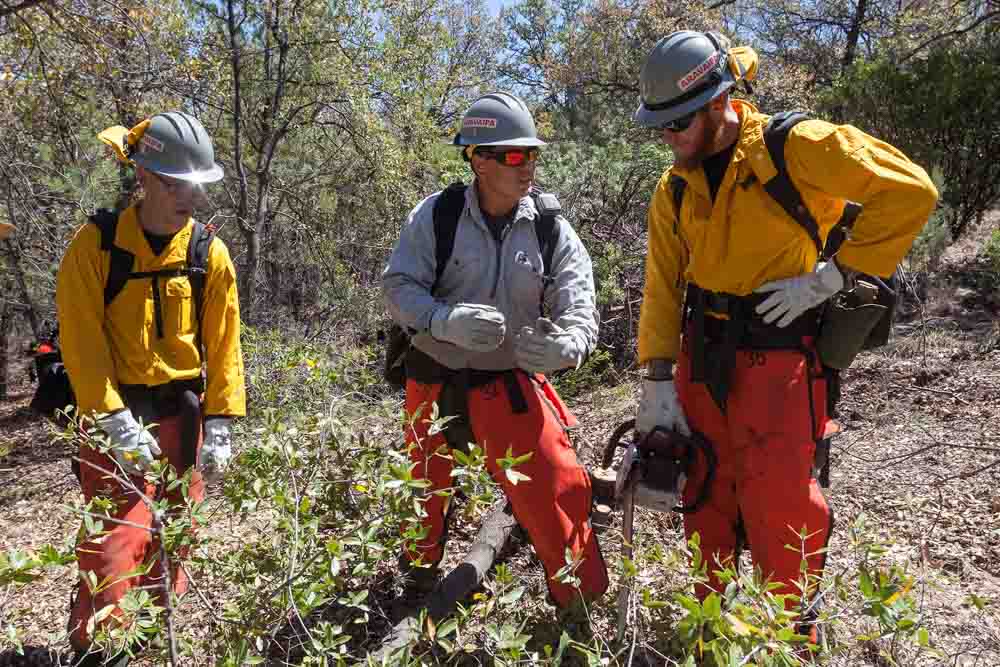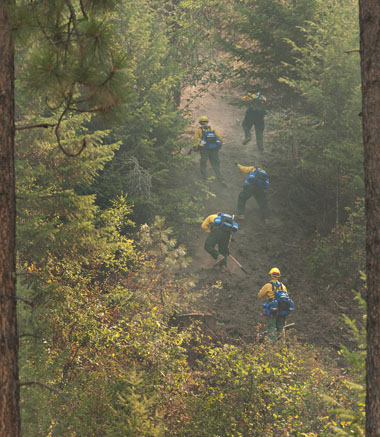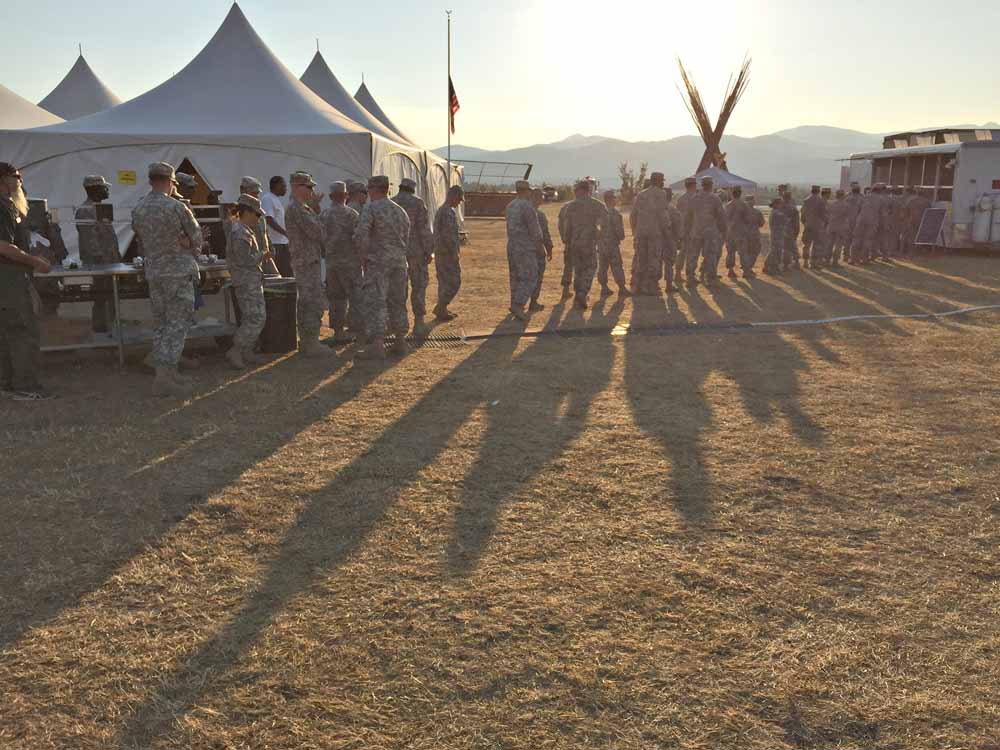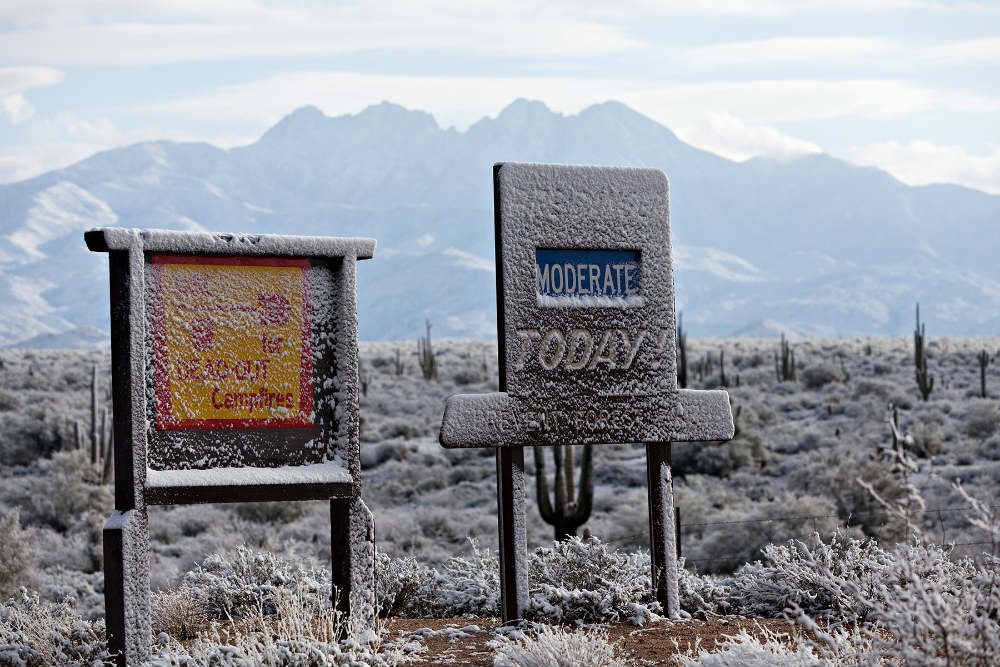Above: Aravaipa crew superintendent Greg Smith, center in black shirt, briefs the crew on the thinning project in the Garden Canyon area of Fort Huachuca.
The photos and article are by Tom Story
Greg Smith has had more preparation than usual to get his crew ready for the upcoming fire season. He is starting the Bureau of Land Management’s (BLM) Aravaipa hand crew from scratch and the task is almost complete.

“This is unique. I know the overhead, most of the overhead, but we know nothing about any of the seasonals, except on paper”, said Mr. Smith. “We are trying to do a veterans crew and right now the numbers are 75 percent vets”.
“The reason that the numbers aren’t higher”, Mr. Smith continued, “is because there aren’t a whole lot of vets with the experience at those higher GS levels; the captain and squad boss positions. All the old vets have moved on into higher up positions or got away from the fire service in general. So now we’re getting a new group of entry-level folks”.
“I was able to pick up a few non-vets with extensive experience: three or four years on a shot crew, which brings a lot to the table where you are starting a new crew” said Mr. Smith who had learned earlier that “strong overhead is key”.
The crew’s overhead positions are all Jackson Hotshot alumni. Mr. Smith brought with him to Sierra Vista both his assistants, Wade Irish and Ryan Hagenah, one of the squad bosses, Anthony Ashalintubbi, and a former squad boss, Daric Burrwith.

“I think we have a pretty good blend. At least seventy-five percent of the crew have some fire experience. Some of the vets came from the vet program. I picked up quite a few of those folks”, continued Mr. Smith.
Mr. Smith started his wildfire career in Arizona with the Coconino National Forest’s Flagstaff Hotshots in 1993 after serving in the Navy. Two years later he moved to the Globe Hotshots on the Tonto National Forest where he spent the next thirteen years, eventually becoming the crew’s superintendent in 2001.
In late 2007, he moved to the Northwest Fire District, outside of Tucson, AZ to help convert Northwest’s highly regarded Type Two Initial Attack crew into a Type One crew. They achieved Type One status in October of 2009, becoming the Ironwood Hotshots. Mr. Smith ran the crew until the Fire District disbanded the crew in 2014. He then joined the BLM and moved to Mississippi to become superintendent of the Jackson Hotshots.

According to BLM State Fire Management Officer Kelly Castillo, in 2015 the National Interagency Fire Center (NIFC) approached the Arizona State office of the Bureau of Land Management about hosting Mississippi’s Jackson Hotshots early in the fire season. “We said yes, but hotshot crews are expensive”, said Mr. Castillo “and being frugal we asked the Gila District folks to find a housing solution”. The district contacted Brad Nicholson, Chief of the Fort Huachuca Fire Department, with the idea of hosting the crew on the Army base adjacent Sierra Vista, Arizona. Chief Nicholson was very enthusiastic about the idea and worked with the base commander to allow the crew to use some available dormitory space. After the BLM and the Army drafted a formal use agreement the Jackson Hotshots completed a successful multi-week tour of southern Arizona in 2015.
“The idea of starting a crew in southern Arizona grew out of bringing Jackson down early in the 2015 season” continued Mr. Castillo, “and since the BLM has a history of having veterans crews, it made good business sense to base them at the Fort”. Besides having the crew be all veterans, the other goal was to have them attain Type One (hotshot) status within three years.

“NIFC allocated the funding for the crew start up and for the remodel of an unused motor pool facility on base” said Mr. Castillo “as well as an increase in annual preparedness funding”.
Mr. Castillo also indicated that the presence of the Aravaipa crew at Ft. Huachuca will serve as a recruiting tool for those in the military looking for opportunities following their military service.
The crew is expected to become available for fire assignments around April 25th.
















